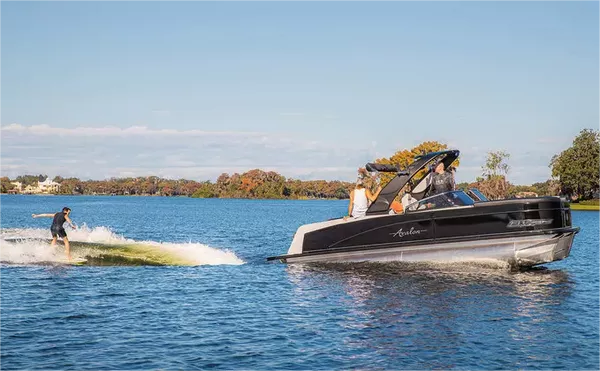Wakeboarding is an exhilarating water sport that combines elements of surfing, water skiing, and snowboarding. While traditionally associated with speedboats and ski boats, wakeboarding behind a pontoon boat offers a unique and enjoyable experience. Pontoon boats, known for their stability and spacious decks, can provide an excellent platform for wakeboarding adventures. In this comprehensive guide, we will delve into the essentials of wakeboarding behind a pontoon boat, from equipment setup to techniques for a thrilling ride.
Pros and Cons:
Pros: Pontoon boats offer a stable platform ideal for beginners, lower speeds conducive to learning, and ample space for family outings. They also tend to be more affordable and versatile for various water activities.
Cons: The wakes generated by pontoon boats are typically less pronounced and can be less consistent compared to specialized wakeboard boats. Slower speeds might impact the wake’s quality and size, making it challenging for more experienced riders looking for bigger air and more dynamic maneuvers.
Safety Considerations:
1. Slower Speeds: Wakeboarding behind a pontoon boat often requires slower speeds (around 15-20 mph) compared to wakeboard boats (20-25 mph). Ensure the boat’s driver is experienced in maintaining a steady speed.
2. Wake Characteristics: The wakes behind pontoon boats are generally softer and less defined, potentially impacting the rider’s ability to perform certain tricks or jumps. Riders should adjust their technique accordingly.
3. Proper Equipment: Always wear a well-fitted life jacket and a helmet for safety. Ensure the wakeboard, bindings, and ropes are in good condition and appropriate for the rider’s skill level.
Pontoon Boat Suitability
To optimize wakeboarding behind a pontoon boat, consider these specifications:
1. Engine Size: A larger engine (150 HP and above) is preferable for maintaining speed and power, especially with added weight from ballast bags or wake shapers.
2. Hull Shape: Look for pontoons with a deeper V-shaped hull to cut through waves more effectively, enhancing wake performance.
3. Weight Distribution: Distribute weight evenly to maintain stability and minimize swaying. Ballast bags can be strategically placed to enhance wake size and shape.
Choosing the Right Equipment
Before hitting the water, it’s crucial to gather the right equipment for wakeboarding behind a pontoon boat:
1. Wakeboard: Select a wakeboard designed for your skill level and weight. Beginner wakeboards are usually wider and more forgiving, while advanced boards are narrower and provide greater maneuverability.
2. Bindings: Invest in wakeboard bindings that fit comfortably and securely. Adjustable bindings are ideal for accommodating different foot sizes.
3. Rope and Handle: Use a wakeboarding rope with minimal stretch for a consistent pull. The handle should be comfortable to grip and have a sturdy construction.
4. Life Jacket: Safety is paramount. Wear a Coast Guard-approved life jacket that fits snugly and allows freedom of movement.
5. Helmet (Optional): Consider wearing a helmet, especially during tricks and jumps, to protect against head injuries.
Setting Up the Pontoon Boat
Prepare the pontoon boat for wakeboarding:
1. Positioning: Anchor the boat in a calm area with deep water. The ideal speed for wakeboarding behind a pontoon boat is around 15-20 mph, depending on the rider’s weight and skill level.
2. Rear-Facing Seating: Optimize the boat’s layout by removing or folding away any rear-facing seats. This creates an unobstructed area for launching and landing.
3. Rear Tow Bar: If available, use a rear tow bar or a tow harness specifically designed for pontoon boats. This attachment ensures a stable and secure connection point for the tow rope.
Getting Started
Follow these steps to launch into wakeboarding behind a pontoon boat:
1. Boarding the Wakeboard: Sit in the water with the wakeboard in front of you. Slide your feet into the bindings and ensure they are snug but not overly tight.
2. Signal to the Boat Driver: Use predetermined hand signals to communicate with the boat driver. A thumbs-up indicates readiness, while a thumbs-down signals to stop.
3. Rope Placement: Hold the handle with both hands and keep your arms extended. The rope should be taut but not overly tense.
4. Begin the Ride: As the boat accelerates, gradually rise out of the water by straightening your legs. Maintain a balanced posture and keep your weight centered over the wakeboard.
Techniques for Wakeboarding Behind a Pontoon Boat
Master these techniques to enhance your wakeboarding experience:
1. Carving: Use your body weight to steer the wakeboard by leaning to the sides. To turn left, shift your weight to the left, and vice versa for turning right.
2. Jumping and Tricks: Start with small jumps and gradually progress to more advanced tricks. Use the wake’s ramp-like shape to launch into the air.
3. Switch Riding: Practice riding with your opposite foot forward for versatility and skill development.
4. Maintaining Balance: Keep your knees slightly bent and absorb the impact of the waves with your legs. Maintain a relaxed posture to minimize fatigue.
Safety Tips
Ensure a safe and enjoyable wakeboarding experience:
- Spotter: Always have a designated spotter on board to monitor the rider and communicate with the boat driver.
- Clear Communication: Establish clear signals between the rider, spotter, and boat driver to avoid accidents.
- Know Your Limits: Gradually progress in difficulty and avoid attempting advanced maneuvers beyond your skill level.
- Respect Water Regulations: Familiarize yourself with local water regulations and always prioritize safety.
Conclusion
Wakeboarding behind a pontoon boat offers a unique and exciting way to enjoy this dynamic water sport. With the right equipment, setup, and techniques, riders can experience thrilling rides and master impressive tricks. Remember to prioritize safety at all times and gradually progress in skill and confidence. So, grab your wakeboard, harness the wake, and embark on an unforgettable wakeboarding adventure behind your pontoon boat!

